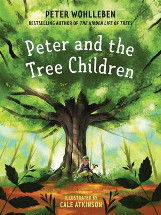Peter and the tree children by Peter Wohlleben

Illus. by Cale Atkinson. Schwartz Books, 2020. ISBN: 9781771644570.
40pp.
(Age: 4-10) Peter Wohlleben, a German forester, writes on ecological
themes. His 2015 bestseller book for adults, The hidden life of
trees, explains in simple language what trees feel and how
they communicate. His writings are based on his own experience
within forests as well as on scientific findings. Peter and the
tree children is his first children's book (apart from a young
readers' edition of The hidden life of trees titled Can
you hear the trees talking) and it introduces children to the
idea of tree families, the importance of old growth forests and the
impact people have on the way forests grow. Peter explains to the
reader in a letter at the start of the book that Piet is a real
squirrel who lives in the forest around his home in Germany and that
in the forest is a spot where no one is allowed to cut down any
beech trees so that the tree family can exist and grow unimpeded.
The fictionalised story follows Peter as he leads Piet through the
forest to find the tree children. Along the way Peter helps Piet to
understand that trees often need the protection of older, taller
trees to grow up properly, that heavy equipment compacts the earth
so that it is difficult for little trees to thrive, that squirrels
help start beech seedlings and that some trees release an
orange-smelling distress signal. There is also some extra
information about trees and their families given at the end of the
story, which expands on the detail given within the story.
The cartoonish illustrations are pleasing enough but lack the
grandeur that could have been useful for portraying the immensity
and intricacies of the forest. This was a missed opportunity, as was
the decision to focus on Piet and his lack of a family (as well as
lots of seemingly empty text) rather than giving more time to the
what, how and why of tree communication. This is inarguably an
important book because of the pressing and unique nature of its
message, but disappointingly it doesn't completely hit the mark.
Nicole Nelson